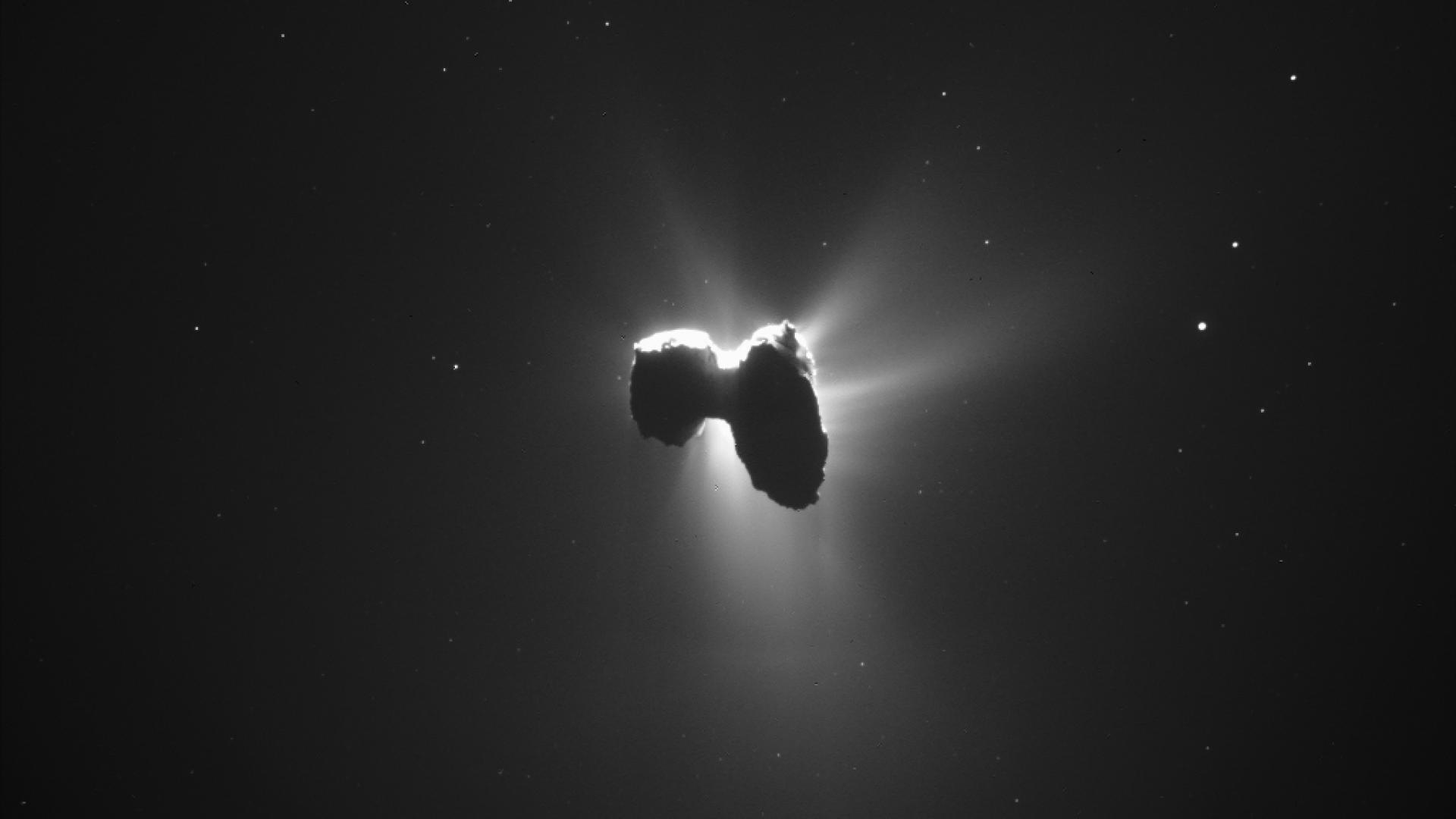Modeling gas and dust around comet Churyumov-Gerasimenko
The European Space Agency Rosetta mission to comet 67P/Churyumov-Gerasimenko (67P/C-G) sent back millions of observations during its journey around the sun. ZIB contributed to the scientific analysis of the space mission by modeling the gas and dust environment around the comet on the HLRN supercomputer.
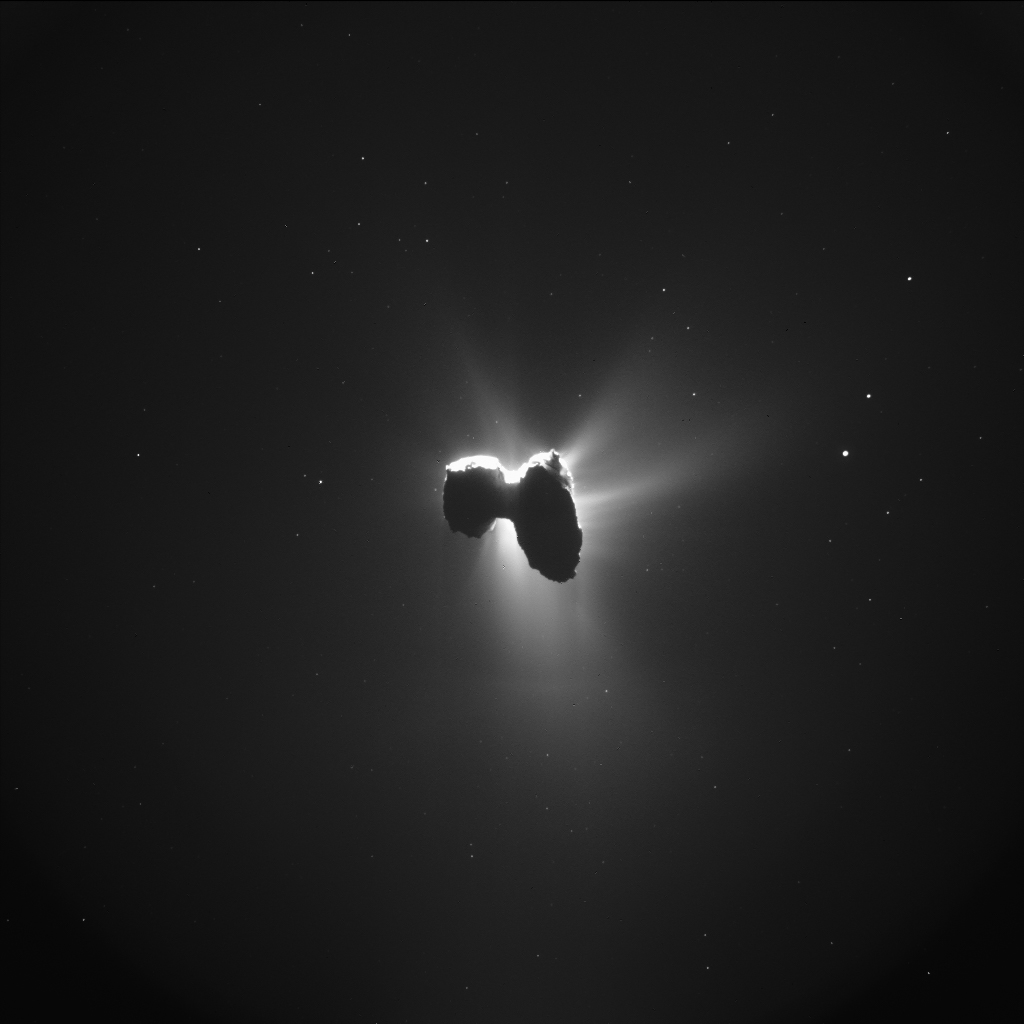 Photo: ESA/Rosetta/NavCam
Photo: ESA/Rosetta/NavCam
Comets: Visitors from OUTER Space and Ancient Times
A spectacular and beautiful show of a bright comet with long tail and large coma is a rare experience for observers from earth. Most comets pass at a safe distance from earth around the sun on highly elongated orbits and are active only during a couple of months at closest approach to the sun (the perihelion). Periodic comets, designated with the suffix P in astronomical literature, are faithful visitors and have been regularly observed starting with comet 1P/Halley (orbital period 75 years).
What makes comets so interesting, apart from the spectacular appearance of the glowing tail that emerges through outgassing and ionization in the near-solar parts of the comet's path?
Comets are messengers from the early stages of the solar system's formation billions of years ago and provide important clues about the early formation of complex molecules. Furthermore, collisions of comets with earth over millions of years provided our planet with organic materials and water.
Earthbound telescopes have no chances to resolve the kilometer-sized nucleus, surrounded by a tenuous gas atmosphere (figure 2); this can be revealed only by satellites making a long journey through space to get very close to the comet. Mass spectrometers, developed for the Rosetta mission at the University of Bern, allow Prof. Kathrin Altwegg's (University of Bern) team to obtain a detailed inventory of molecular abundances and isotopic ratios.
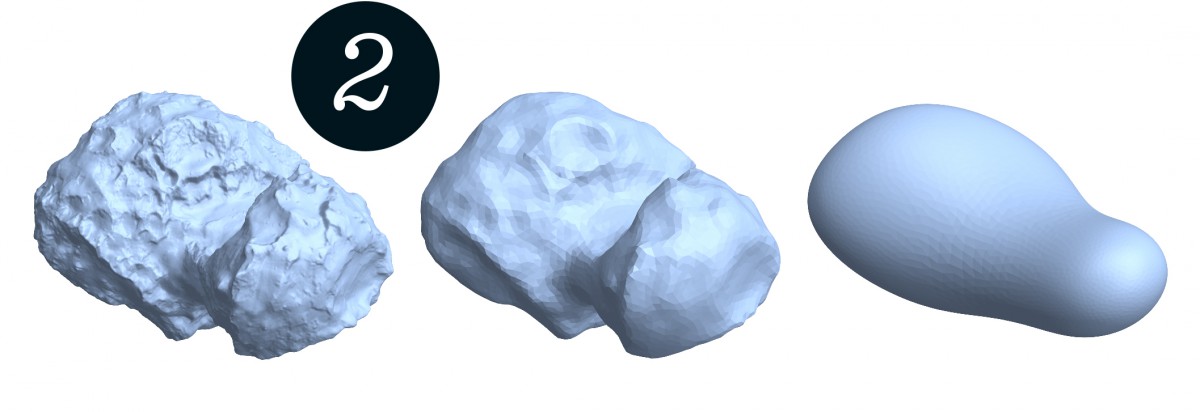 The nucleus of 67P/Churyumov-Gerasimenko: a space potato sized 4 km x 3.5 km x 3.5 km, consisting of dust (carbon-rich compounds and silicates) and ice. The complex shape of the rotating nucleus requires high-resolution mesh-based models for the dust and gas emission across the surface (FN:T. Kramer, M. Noack, D. Baum, H.-C. Hege, E.J. Heller. Homogeneous dust emission and jet structure near active cometary nuclei: the case of 67P/Churyumov-Gerasimenko. Advances in Physics X, 3, 1404436 [2018]. http://dx.doi.org/10.1080/
The nucleus of 67P/Churyumov-Gerasimenko: a space potato sized 4 km x 3.5 km x 3.5 km, consisting of dust (carbon-rich compounds and silicates) and ice. The complex shape of the rotating nucleus requires high-resolution mesh-based models for the dust and gas emission across the surface (FN:T. Kramer, M. Noack, D. Baum, H.-C. Hege, E.J. Heller. Homogeneous dust emission and jet structure near active cometary nuclei: the case of 67P/Churyumov-Gerasimenko. Advances in Physics X, 3, 1404436 [2018]. http://dx.doi.org/10.1080/
23746149.2017.1404436.). Simplified shape models help to pin down the sources of gas and dust emitted from the surface.
Rosetta's long journey to comet 67P/Churyumov-Gerasimenko
The comet 67P/C-G has been expelled by Jupiter from the cold, outer regions of our solar system and is presently losing about 1/2000 of its total mass on each of its 6.4-year round-trips.
Rosetta followed the path of 67P/C-G from close distance (20–200 km) to find out how water and dust are distributed on the comet and which factors drive the development of the dust and gas tail and inner atmosphere (coma). Astronomers have a difficult task predicting the activity of a specific comet and to link the often million-kilometer-long tail to specific physical processes at the surface of the only few-kilometer-sized nuclei.
Predicting the tails of comets
At ZIB, we developed a detailed dust and gas forecast for 67P/C-G that has been compared with the downlinked images. Of particular interest are agglomerations of dust in space, imaged as brighter strikes around the nucleus and referred to as "jets." Before Rosetta's encounter, it was hypothesized that the dust jets are caused by isolated patches of activity on the surface (pointing to a large heterogeneity of the surface composition).
To analyze this in detail requires the development and implementation of models for simulating millions of dust particles around the rotating nucleus, taking into account the acceleration of dust grains by the evaporating gas and the gravitational pull of the odd-shaped nucleus. An effective parallelization is required, which allows us to simulate different scenarios. One unexpected outcome of the simulations performed at the HLRN supercomputer facility hosted at ZIB is that it is possible to predict the near-surface dust distribution of 67P/C-G with high accuracy just based on the shape of the nucleus.
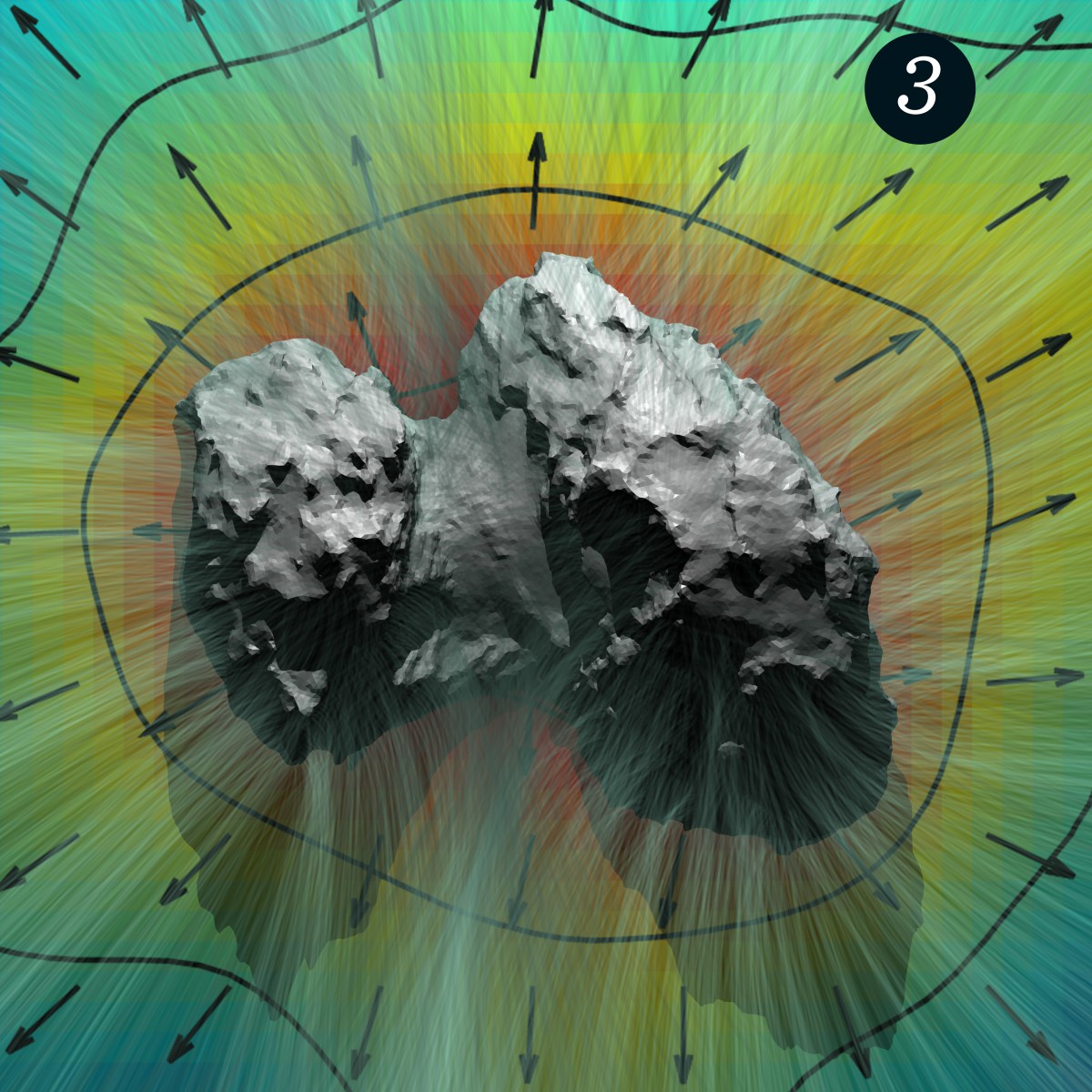 Simulation of dust trajectories from the sunlit and shaded surface. Dust is accelerated within the gas field (arrows) and is lifted off the surface. The rotation of the comet during the travel time of the dust results in curved trajectories due to the Coriolis force [1].
Simulation of dust trajectories from the sunlit and shaded surface. Dust is accelerated within the gas field (arrows) and is lifted off the surface. The rotation of the comet during the travel time of the dust results in curved trajectories due to the Coriolis force [1].
The Shape of the Nucleus and the Observer Perspective
In a collaboration between the Supercomputing and Visual Data Analysis departments at ZIB, we used the Amira software to deform a mesh representation of the nucleus to study how the curvature of the surface affects the dust release. The best match between the model and Rosetta's observation is obtained if we consider globally uniform dust emission from the entire sunlit nucleus, instead from localized patches. This suggests a rather homogeneous composition of the surface of 67P/C-G. Higher dust levels are stemming from concave areas on the surface, which act as a lense, leading to a convergence of dust trajectories several kilometers above the surface (figure 3).
How can our findings be reconciled with the rapidly changing appearance of "jets" around 67P/C-G seen in many images? The 3-D visualization of the modeled dust cloud reveals that the imaged dust concentrations are highly sensitive to the perspective of the observer (Rosetta's camera). Higher intensities in the images ("jets") are caused by multiple concave areas aligned along the line of sight (figure 4). Our simulations take into account the 12-hour rotation of the nucleus, which lead to the curved appearance of dust jets further away from the nucleus: any observer standing on the cometary surface would get firsthand confirmation of the Coriolis effect.
 Image analysis of the brightest point in the Rosetta image taken on April 12, 2015, 12:12, decomposed into all contributing dust sources along the line of sight (yellow line) from Rosetta's perspective. The bright jet seen from Rosetta's perspective originates from multiple sources and, in addition, from background contributions from all sunlit surface areas (FN:T. Kramer, M. Noack. On the origin of inner coma structures observed by Rosetta during a diurnal rotation of comet 67P/Churyumov-Gerasimenko. The Astrophysical Journal Letters, 823, L11 [2016]. https://doi.org/10.3847/2041-8205/823/1/L11.).
Image analysis of the brightest point in the Rosetta image taken on April 12, 2015, 12:12, decomposed into all contributing dust sources along the line of sight (yellow line) from Rosetta's perspective. The bright jet seen from Rosetta's perspective originates from multiple sources and, in addition, from background contributions from all sunlit surface areas (FN:T. Kramer, M. Noack. On the origin of inner coma structures observed by Rosetta during a diurnal rotation of comet 67P/Churyumov-Gerasimenko. The Astrophysical Journal Letters, 823, L11 [2016]. https://doi.org/10.3847/2041-8205/823/1/L11.).
The Gas Atmosphere
Bright, short-living outbreaks resulting in very bright localized dust jets, have also been observed in the weeks around perihelion (August 12, 2015). In collaboration with the Rosina/COPS team at the University of Bern, data points from the cometary pressure sensor instrument onboard Rosetta allowed us to reconstruct the most likely gas sources linked to the observed outbreaks. As it turns out, the dust outbreaks are not happening at random locations, but are highly correlated with carbon-dioxide-rich areas (figure 5). This is interesting because for the total gas emission on 67P/C-G, the water emission tops the carbon-dioxide release.
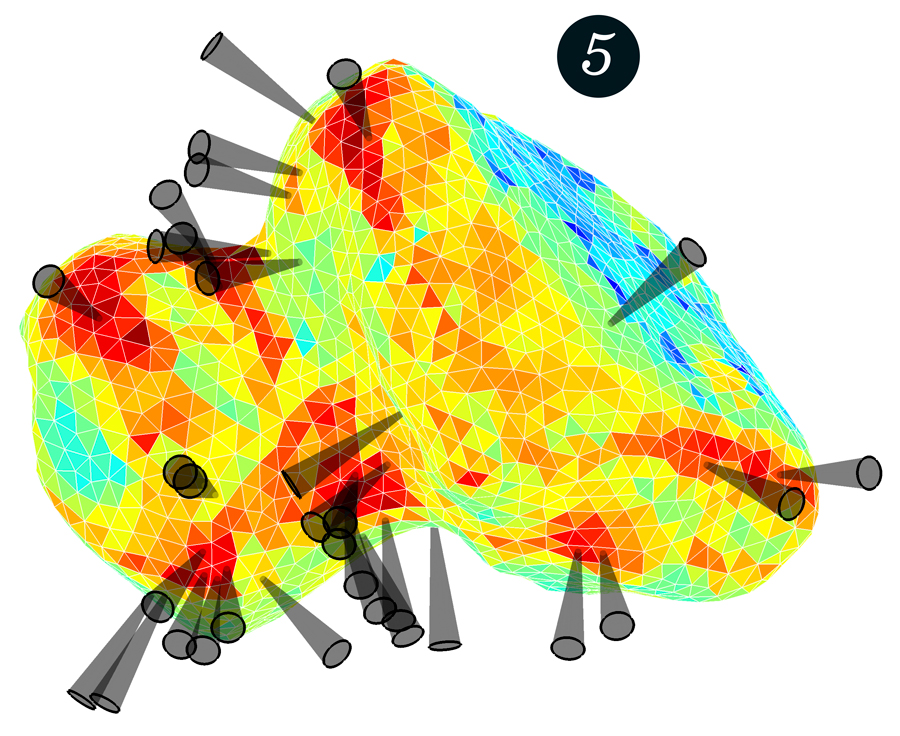 Reconstruction of carbon-dioxide sources on the surface of 67P/C-G and locations of observed dust outbreaks (FN:T. Kramer, M. Läuter, M. Rubin, K. Altwegg. Seasonal changes of the volatile density in the coma and on the surface of comet 67P/Churyumov-Gerasimenko. Monthly Notices of the Royal Astronomical Society, 469, S20–S28 [2017]. https://doi.org/10.1093/mnras/stx866.), (FN:J.B. Vincent, M.F. A’Hearn et al. Summer fireworks on comet 67P. Monthly Notices of the Royal Astronomical Society, 462, S184–S194 [2016]. https://doi.org/10.1093/mnras/stw2409.).
Reconstruction of carbon-dioxide sources on the surface of 67P/C-G and locations of observed dust outbreaks (FN:T. Kramer, M. Läuter, M. Rubin, K. Altwegg. Seasonal changes of the volatile density in the coma and on the surface of comet 67P/Churyumov-Gerasimenko. Monthly Notices of the Royal Astronomical Society, 469, S20–S28 [2017]. https://doi.org/10.1093/mnras/stx866.), (FN:J.B. Vincent, M.F. A’Hearn et al. Summer fireworks on comet 67P. Monthly Notices of the Royal Astronomical Society, 462, S184–S194 [2016]. https://doi.org/10.1093/mnras/stw2409.).
Preparing the next rendezvous with 67P/C-G
neous telescopic observations provide a unified picture of the evolution of the surface and the coma of a comet. A follow-up mission to comet 67P/C-G at its next visit to the inner solar system has been proposed and might lead to an unexpected reunion with Rosetta and its lander Philae. If the theoretical models pan out, next time we might be able to predict what the images of the dust tail and coma of 67P/C-G will look like.
Collaborations and funding:
- Prof. Kathrin Altwegg, University of Bern, Switzerland, responsible for the Rosina: Rosetta Orbiter Spectrometer for Ion and Neutral Analysis instrument onboard Rosetta and the COmetary Pressure Sensor (COPS)
- Dr. Martin Rubin, University of Bern, Switzerland
- Mattias Malmer, Stockholm, Sweden (reconstruction of the shape of the nucleus based on navigation camera images)
- Prof. Eric J. Heller, Department of Physics, Harvard University, USA
- Simulations were performed on the HLRN supercomputing facilities at ZIB
Authors:
- Tobias Kramer, kramer@zib.de, +49 30 841 85-360
- Matthias Läuter, laeuter@zib.de, +49 30 84185-421
- Matthias Noack, noack@zib.de, +49 30 84185-328
- Hans-Christian Hege, hege@zib.de, +49 30 84185-141
- Daniel Baum, baum@zib.de, +49 30 84185-293
